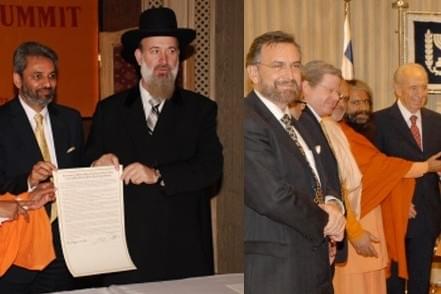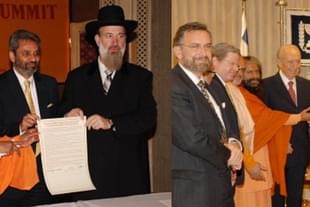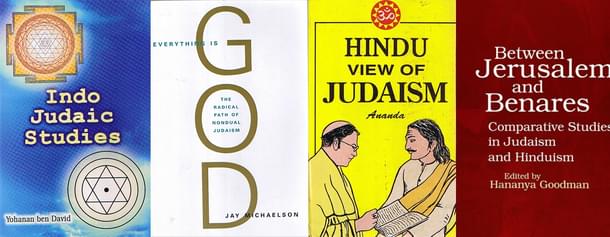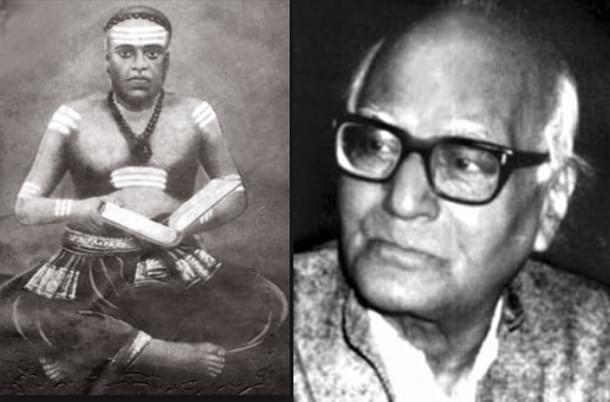Culture
Hindu-Jewish Dialogues: A Model For Honest Discourse - Part Two
Aravindan Neelakandan
Sep 07, 2018, 01:28 PM | Updated 01:27 PM IST
Save & read from anywhere!
Bookmark stories for easy access on any device or the Swarajya app.


The remarkable similarity between the thoughts of Gosthen-Gottstein and Ram Swarup can provide both Hindus and Jews the much needed common ground to enter a dialogue.
Hindu-Jewish Dialogues: A Model For Honest Discourse - Part One
After elaborately going through the history of Jewish experience in India, Goshen-Gottstein, goes onto explore in detail the two summit meetings held in the years 2007 and 2008. The Hindu Dharma Acharya Sabha (HDAS) under Swami Dayananda represented the Hindu side while the Chief Rabbinate of Israel, along with the American Jewish committee represented the side of Judaism. This chapter and the concluding chapter of the book are very important for Hindus to understand what a spiritually inclined Jew in dialogue with Hinduism expects from Hindu leaders and there is a sense of deficiency there. The author suggests that the Hindu side views the problem of ‘one-god other god’ through the Christian lens and hence “the centrality and the consequences of Avoda Zara to a Jewish view of other religions seem to have never been made part of the discussion”. (p. 178)
Gosthen-Gottstein is critical of Hindus because for him they have been hesitant in going the full length in their dialogue with their Jewish brethren. The author feels that given the vast spiritual space that is available for discussing the differences with ‘mutual respect’ between both the religions, a significant part of the dialogue has been missing in the two summits:
There are enough indications at hand to suggest that even the question of Avoda Zara would not be a stumbling block to meaningful engagement between Judaism and Hinduism. … We have seen that Jews have shown massive interest in Hinduism as a spiritual reality. This, … has not been reciprocated by Hindus. The one Hindu driven encounter, and an important one at that, was not driven by spiritual concerns, but by political concerns, related to the Hindu quest for maintaining identity. Thus far, Jews and Hindus have not been involved in the same process in the same way. While they have met, the agendas, roles, and expectations have not been reciprocal.
In the end he summarises six points.
The very happening of Hindu-Jewish encounter is significant for the author but he points out that “there is much more to the encounter than the potential of reaching out in universal friendship”. The second is the “rich, complex, and multifaceted” nature of the encounter. The third point is the need for reciprocality in the dialogue. He elaborates on this repeatedly. The Hindu-driven dialogue has its own purpose and does not converse with core-Judaism. If it is because of the problematic 'Avoda Zara', then he points out “there are enough indications at hand to suggest that even the question of Avoda Zara would not be a stumbling block to meaningful engagement between Judaism and Hinduism”.
The fourth point is how it can benefit the Jewish worldview in dialogue: “While any inter-religious encounter is occasion for revisiting our philosophical worldview, the encounter with Hinduism is particularly suggestive in this respect, in view of the enduring view of India as a land of sages.”
In the fifth point again the author speaks of asymmetry in the ‘domain of spirituality’. With the public image that suggests India or Hinduism as ‘spirituality’s natural home ... Jews are seen as in need of Hindu spirituality’ so ‘a two-way exchange on spirituality to the benefit of Hindus is never entertained.' He observes:
And yet, precisely because spirituality is not the possession of one religion only, much of what draws Jews to Hinduism is a domain that is common to both traditions. ... This is also what allows some Jews to transition from Hinduism to Judaism or to establish various modes of synergy between the religions. A common core remains across such transitions. It informs the quest, the exploration, the return, and, ultimately, the ability to construct firm bridges of meaning and sharing between the traditions. This is the bridge of spirituality.
The sixth point is “complementing the theological and spiritual opportunities” through the dialogue. He points out there is no identity crisis in Jewish encounter with Hindu spirituality and that it provides only “room for a positive embrace of the spiritual encounter" where "benefits outweigh the associated risks". Even if there are any such perceived identity threats they can be “greatly reduced if Jewish tradition spoke as much to a Hindu audience as Hindu tradition speaks to a Jewish audience”.
The issues of the lack of reciprocality and asymmetry, even if found rather repetitive, the truth is that Hindus have been reluctant to study Judaism as a spiritual tradition. The reason is not far to seek. They view Judaism through the Christian-Islamic lens. And it is also true a significant Jewish scholars, most of them non-religious, in the West have viewed Hinduism through evangelical-colonial or Marxist-colonial lenses. Perhaps the Jewish side should also realise this as a mutual problem that their very first exposure to Jewish spirituality gets coloured by Christian theology.
Hindu seekers will surely find Kaballah as spiritually elevating as any Vedantic spiritual tradition without the fear of loss of identity. Hananya Goodman edited in 1997 the book, Between Jerusalem and Benares Comparative Studies in Judaism and Hinduism, with a preface by David Shulman. It is a collection of 12 scholarly articles (including one by Wendy Doniger who has now firmly established herself in the anti-Hindu academic-media cottage industry). This book interestingly has not a single Hindu contributor. The Indian edition of the book is published as part of Satguru Garib Dass Oriental Series (1997).
The author of the book under review would find an interesting paper ‘A Hindu Response to the Written Torah’ (Dennis Hudson) in the compilation Between Jerusalem and Benares. Sri Lankan Saivaite scholar Arumuga Navalar (1822-79) had made an in depth study of the so-called Old Testament. Though only a Christian translation, the scholar was able to see the Hebrew religion as a separate spiritual tradition standing on its own without the Christian baggage and could draw parallels between that and Hindu religion, ultimately seeing Christianity as polytheistic while Hindu Saivism and Judaism as more monotheistic in a much deeper spiritual meaning of the term.
The academic asymmetry seen here should be seen along with the general Hindu lack of enthusiasm that the author describes in the book. Indian academia is dominated by Hindu-phobic leftists who also have an anti-Israel stand that borders anti-Semitism. This goes back to Nehru himself. Dr Immanuel Olsvanger in the diary of his Indian visit, records that he was told by Nehru that his support for ‘the national movement of Arabs’ would not be diminished by “the fact that the nationalist Arab movement coincides with Hitler’s interests”.
Dr Yohanan Ben David points out that Gandhi himself has read only “the so-called Old Testament in translation made by Christians" and hence it was not surprising that he was writing as late as 1938 about “stigma" of crucifying Jesus was upon the Jews (Yohanan ben David, Indo Judaic Studies, 2002). In Olsvanger’s diary the only person who shows interest in studying Judaism, its culture and people, through student exchange programmes between the two peoples turns out to be Pandit Madan Mohan Malaviya - the founder of Banaras Hindu University and the Hindu Mahasabha leader in Congress. In independent India it is the Nehruvian worldview that holds sway. So the general Hindu population lacks any direct means of understanding Judaism while it has access to both Christianity and Islam, which in turn colour its view of Judaism.

Yet there have been attempts. One is by ‘Ananda’ of Ramakrishna Math and Mission- Hindu View of Judaism (1996). The book praises Jews and Judaism exhorting Hindus to learn from them: “But the Hindus forgot these virtues which spoke against covetousness and untruth whereas the Jews fought any number of wars and underwent utmost sufferings for the upholding of the same virtues for centuries” (p.251). The context is not the usual Israel-Jews identity but the social ethos of non-coveting.
The whole book though not well organised discovers various parallels between Hebrew Bible and Vedanta, particularly from the Ramakrishna-Vivekananda tradition. Another one good start has been the book by Jay Michaelson ‘Everything is God: The Radical Path of Nondual Judaism’ (2009). Particularly interesting are the passages that deal with the Ramakrishana-Vivekananda Vedanta and ‘non-dual Neo-Hasidism’. This is a book pregnant with possibilities for a serious spiritual dialogue between Hindus and Jews beyond the identity-centric ones.
Now the author comes to his own experience. What is it that as a Jew, the Hindu encounter gave him:
I note how at home I felt spiritually wandering from group to group. I visited multiple communities of all shades and practices, monks and householders, representing the huge array of Hindu groups. And throughout I felt at home, with a sense of deep fraternity, notwithstanding all outer forms of difference, theirs as well as mine. ... Otherness is deeply ingrained in the Jewish psyche. There is plenty in the Hindu reality that feels different, strange, belonging to a religious other. ... The sense of union of ultimate quest, sharing in the spiritual life, and a deep sense of spiritual brotherhood was there without my needing to “make room” for it. Where did it come from? Certainly not from academic analyses of the religion. ... In my case, it was the fruit of a long journey that focused on the spiritual riches of Hinduism. But one of its fruits, perhaps the most important one, is that I consider myself to be completely free of the subtle, all too subtle, boundaries of heart that keep the religious other at a distance. The kind of unity that has opened up is very different from a secular humanist unity. It is a unity that grows from deep common purpose, from shared concern.
This concluding passage is very important for it places Goshen-Gottsetin in the same context of Sarmad. The essence of ‘Hinduness’ (which translates to Hindutva rather than Hinduism) is that it appeals to the fundamental unity while accepting the diversity and pluralism - even encouraging them. This exploration of ‘unity in diversity’ or the ‘One in the many and the process of One becoming many’ (Bhagavat Gita: ) In this way Dara Shikoh was a Hindu and only in this context Sarmad could have been simultaneously both Hindu and Jew. The cover illustration of the book titled, The Jewish Encounter with Hinduism showing Dara Shikoh and Sarmad thus attains a greater significance of its own.

Coming back to reciprocality and removing the asymmetry in Hindu-Jewish dialogue that the author perceives, Hindus can definitely take bold steps. Perhaps, the following thoughts of Hindutva seer-thinker Ram Swarup is important in this regard:
When the urge for unity is spiritual, the theology of One God is no bar and the seeker reaches a position no different from Advaita, from ekant sat. ... Like monotheism, polytheism too is subject to the despiritualizing influences of the externalizing mind. The Gods of polytheism tend to lose their inwardness and thus they also lose their inner unity. In India, this has happened again and again. On such occasions, sages appeared and by their life and work tried to restore to the Gods their inwardness and unity. In India, this has happened again and again. On such occasions, sages appeared and by their life and work tried to restore to the Gods their inwardness and unity. ... Again, like monotheism, polytheism too has its spiritual motive. If monotheism represents man’s intuition for unity, polytheism represents his urge for differentiation. ... Monotheism is not saved by polytheism, nor polytheism by monotheism, but both are saved by going deep into the life of the soul. In the soul, there are no distinctions between the One and the Many. God or Gods do not exist there in the same way as they exist in the intellect. Depending on the cultures in which they are bom, mystics have given monotheistic as well as polytheistic renderings and interpretations of their inner life and experiences.The Word as Revelation: the Names of Gods, 1980
The remarkable similarity between the conclusion of Gosthen-Gottstein (2016) and the observation of Ram Swarup (1980) can provide both Hindus and Jews entering a dialogue the much needed common ground.
Aravindan is a contributing editor at Swarajya.





